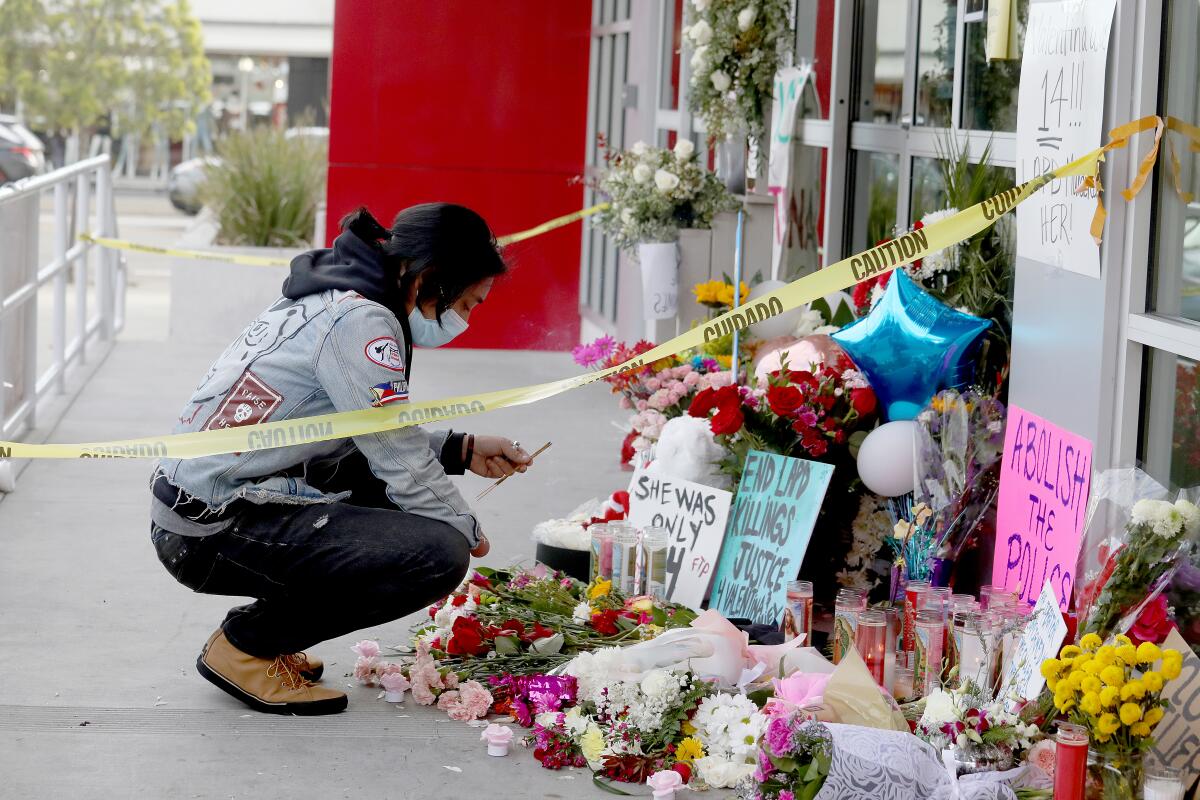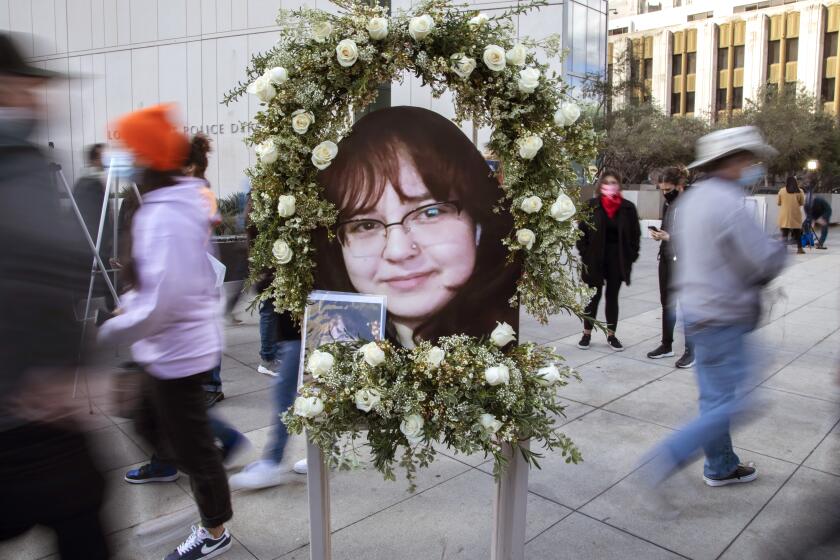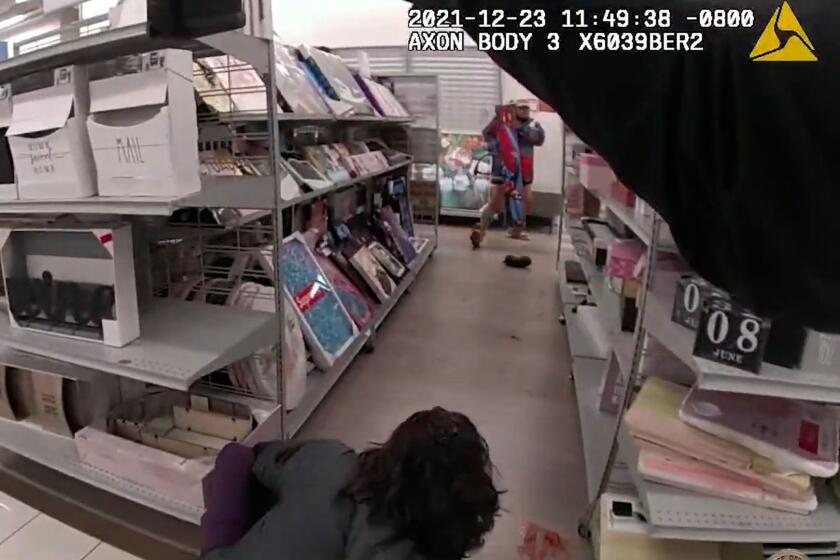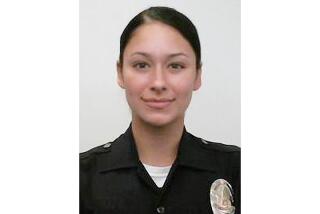Decades before LAPD killed girl, a wild shootout blocks away helped militarize police

Policing in Los Angeles changed forever on the morning of Feb. 28, 1997, when Americans watched on live TV as a 44-minute firefight unfolded between two heavily armed bank robbers and outgunned LAPD officers at a Bank of America in a bustling North Hollywood shopping district.
In the end, nearly 2,000 bullets were fired, the two robbers were killed, and multiple officers and civilians were injured in the now-infamous showdown, which helped usher in the modern era of militarized police.
Last week, another shocking incident just three blocks away offered a tragic postscript to the high-powered approach that police adopted after the bank shootout.
A Los Angeles police officer carrying an assault-style rifle rushed with several other officers into a Burlington department store after receiving reports that a man was attacking people inside. The officer charged ahead to confront a man who had attacked shoppers with a bike lock, firing three rounds and killing the man seconds after first laying eyes on him.
But those shots also killed 14-year-old Valentina Orellana-Peralta, who was hiding in a nearby changing room with her mother and was struck by one of the rounds after police say it ricocheted off the floor and pierced a wall.
Those two violent events â 24 years apart â demonstrate the pendulum swing in American law enforcement that has become a part of the outrage that followed Valentinaâs killing.
After the shootout, the LAPD and law enforcement agencies across the country boosted their firepower, equipping officers with high-powered rifles and other weaponry. The LAPD also authorized its officers to carry high-caliber handguns, and Los Angeles passed a series of gun control measures.
The officer who killed Valentina fired a military-grade rifle.
The LAPD released an edited video Monday of 911 calls, store surveillance footage and scenes from officersâ body cameras, which has fueled debate about the police tactics and whether the girl had to die.
There are many unanswered questions about the shooting, including whether the officers believed that the lock-wielding man, 24-year-old Daniel Elena-Lopez, was armed with a gun when they entered the store.
Also among the key questions, experts who reviewed the video said, is why an officer would discharge an assault-style rifle in a store, and whether the decision to do so was improper. But experts, advocates and other observers also raised concerns about whether force was justified, whether the police should have commanded Elena-Lopez to surrender and the constitutionality of the officersâ actions.
George Kirkham, a former police officer and professor emeritus at the Florida State University College of Criminology and Criminal Justice, said the officer should not have fired a military-grade rifle inside a store.
The parents of Valentina Orellana-Peralta, fatally shot by LAPD at a Burlington store in North Hollywood, call for justice for their daughter.
âThe first question is why was a guy carrying a weapon like this?â he asked. âThis is a very, very risky weapon, a weapon of enormous lethalityâ that has a long range and high penetration rate.
According to Kirkham, studies of police shootings have found that the hit rate is about 17%, creating the potential for errant rounds to endanger bystanders.
âBullets go all over the place,â he said.
Greg Meyer, a retired LAPD captain and nationally recognized use of force expert, disagreed with the notion that police should not have had a high-powered weapon in tow when they entered the Burlington store, given what they had been told about the circumstances they would face inside.
âYou absolutely want to have the rifle up front in this situation. Thatâs normal for what you believe will be an active shooter situation,â he said.
It appears that police believed they were in such a high-danger scenario because at least one 911 caller erroneously told an emergency dispatcher that there had been a shooting at the store and that the man had a gun.
Though that assertion later turned out to be false, police have to operate based on the best information they have available, according to Seth Stoughton, a former Florida police officer and University of South Carolina law professor who studies shootings and has co-authored a book on police use of force.
âWhen officers get the information, âactive shooter, shots fired,â without strong evidence to the contrary, theyâre going to respond as if itâs an active shooter, shots fired,â he said, adding that in modern policing, that means âgoing in hard and fast, basically.â
Because of that reality, itâs vital that any information dispatchers give to police is as accurate as possible, Stoughton said.
âItâs so incredibly important for call takers to gather all of the relevant information and for dispatchers to relay all of that information to officers, and for officers to make active use of their dispatcher by asking for additional information,â such as whether a suspect is armed or intoxicated, Stoughton added.
In 2012, the perils of providing inaccurate information to police were made tragically clear when Pasadena police shot and killed unarmed 19-year-old Kendrec McDade. Prosecutors later determined that the officers had acted on a false assumption that McDade was armed, based on a report by a 911 caller who erroneously told a dispatcher he had been robbed at gunpoint.
Still, no matter what dispatchers told them before they arrived on the scene Thursday, Kirkham said police should have shouted commands at Elena-Lopez â ordering him to turn around, get on his knees and put his hands behind his head â instead of immediately shooting him.
âThis does not look like what we would call a good shoot,â the Florida State University professor emeritus said.
Stoughton noted that while itâs important to assess what police, dispatchers and other responders could have done better, the fact that an encounter ended in tragedy doesnât necessarily mean anyone did anything wrong.
âSometimes officers donât make the ideal tactical choice, and thatâs OK. It sucks, itâs not great, itâs not what we want,â he said. âBut in terms of assessing an officerâs tactical decisions, the question isnât did they use textbook-perfect tactics, the question is whether the tactics they used were reasonable at the time and under the circumstances.â
Jonathan Smith, executive director of the Washington Lawyersâ Committee for Civil Rights and Urban Affairs, oversaw investigations into 23 police departments as chief of the Special Litigation Section of the DOJâs Civil Rights Division.
He said the Constitution makes it clear that officers can use deadly force only when they or others face a serious and immediate threat to their life and safety, and that he did not perceive that level of threat in the video.
âIâm troubled by the shooting and use of deadly force under these circumstances,â Smith said. âAt the moment that the trigger was pulled, there was not an immediate threat to the officer or victim.â
He said multiple factors must be considered when evaluating police shootings.
In this case, he said, the suspect was on the other end of an aisle and not close enough to the officer or the woman on the ground to cause harm.
Los Angeles attorney Jorge Gonzalez echoed that sentiment.
âThey have to basically articulate the facts that justify their shooting, but I donât see it looking at the video,â said Gonzalez, who has represented people shot by police.
âYou never see [Elena-Lopez] pointing a gun.â he said.
But Meyer said he believes that while much is still unknown about the incident, the officersâ actions, considering the information they had been given about the circumstances inside the store, were constitutional under the U.S. Supreme Courtâs decision in the 1989 case Graham vs. Connor.
âThis is a classic situation that the United States Supreme Court calls âtense, uncertain and rapidly evolvingââ in Graham, Meyer said. âThe officers basically seemed to assess that they were going into a potential active shooter situation, and they went in as they were supposed to, with a rifle in the lead, and when they finally caught up to the suspect it all depends on what threat the officer who fired perceived.â
Kevin Robinson, an instructor at the Arizona State University School of Criminology and Criminal Justice and former Phoenix Police Department assistant chief, said the video paints only a partial picture of the tragedy. The most important information will come from interviews with the officer who fired the weapon.
âItâs going to depend on that officer and what he saw,â Robinson said. âYou have to know what the officer was thinking.â
âRight now,â he said, âwe donât know anything.â
Dmitry Gorin, a Los Angeles defense attorney and former prosecutor who has handled at least a dozen cases involving extensive police use of force and shootings, said second-guessing officers in an active shooter incident is very difficult.
The LAPD released video of the fatal police shooting inside a Burlington clothing store last week that left a suspect and a 14-year-old girl dead.
But in civil court, Gorin said, he expects the LAPD will have to pay a significant settlement for the wrongful death of Valentina.
For Marisol Marquez, the girlâs killing brought back memories of a deadly LAPD shooting of a 14-year-old boy just steps from her Boyle Heights home in 2016.
In that incident, police alleged that Jesse Romero fired a gun at an officer â which was disputed by witnesses who said the weapon discharged after it was tossed aside by the teen.
Marquez, a member of the Boyle Heights Neighborhood Council, said both killings are a result of what she views as negligence by officers who too often resort to deadly force instead of less-lethal options.
âItâs not OK that a 14-year-old has to die in her motherâs arms,â said Marquez, who just celebrated her daughterâs first birthday. âThereâs no accountability.â
More to Read
Sign up for Essential California
The most important California stories and recommendations in your inbox every morning.
You may occasionally receive promotional content from the Los Angeles Times.














